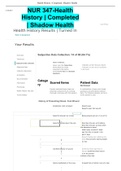Resume
Global Banking - Summary - All information of HOC's
- Établissement
- Vrije Universiteit Brussel (VUB)
Professor Simons, gave this course for the first time in 2024, that is why i made a new summary. It contains all the important information needed to know for the exam. I did not use the book to study along with it and received a 17/20 for the exam.
[Montrer plus]












